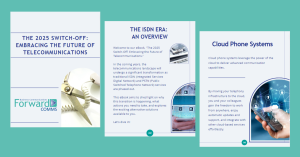In the world of telecommunications, technology is constantly evolving, and older systems are gradually phased out to make way for more advanced solutions. Two such systems, ISDN (Integrated Services Digital Network) and PSTN (Public Switched Telephone Network), are nearing the end of their lifecycle. This blog aims to educate you about the upcoming ISDN and PSTN switch-off, helping them understand the implications and prepare for the transition to modern communication alternatives.
Understanding ISDN and PSTN:
ISDN and PSTN have been the backbone of traditional voice and data communication for several decades. ISDN offers digital voice, video, and data transmission over copper lines, while PSTN is the traditional analogue telephone network. However, advancements in internet technology have led to more efficient and cost-effective alternatives, making the retirement of ISDN and PSTN networks inevitable.
The Switch-Off Timeline:
Telecom regulatory bodies and service providers have announced plans to phase out ISDN and PSTN networks. While specific timelines may vary across regions and providers, you will need to have upgraded by 2025.
Impacts on Business and Residential Customers:
a. Business Customers: Many businesses still rely on ISDN for their phone systems and data connectivity. The switch-off will require companies to transition to alternative solutions, such as Voice over IP (VoIP) and cloud-based Unified Communications (UC) platforms. Start planning early to avoid disruptions and ensure a smooth transition without loss of service or productivity.
b. Residential Customers: PSTN switch-off will primarily affect customers using landline phones connected to the analogue network. To maintain telephone service, users will need to explore alternative options, including VoIP, mobile phones, or internet-based voice services. Contact your telecom provider for guidance on alternatives and necessary equipment upgrades.
Transitioning to Modern Alternatives:
a. VoIP: Voice over IP is a flexible and cost-effective solution that uses the internet to transmit voice and data. It offers a wide range of features, including video conferencing, virtual numbers, call forwarding, and more. Consider adopting VoIP systems for both business and residential needs.
b. Unified Communications: UC platforms integrate various communication channels such as voice, video, messaging, and collaboration tools into a unified system. Migrating to a cloud-based UC solution ensures seamless connectivity and enhances team productivity and collaboration.
c. Mobile Solutions: Mobile phones have become a popular alternative to traditional landlines. Explore mobile plans that offer unlimited or cost-effective voice minutes to meet your communication needs.
d. Equipment Upgrades: Depending on the alternative solution chosen, you may need to upgrade your hardware or invest in IP-enabled devices. Consult with your telecom provider or an IT professional to determine the necessary equipment changes.
The imminent switch-off of ISDN and PSTN networks marks a significant milestone in the evolution of telecommunications. It’s essential for businesses to stay informed and plan ahead to ensure uninterrupted communication services. Embrace the opportunities presented by modern alternatives like VoIP, Unified Communications, and mobile solutions. By working closely and considering your specific needs, you can smoothly navigate the switch-off and leverage the benefits of advanced communication technologies.
Reach out to us on 01438 745574 or email us at sales@forwardcomms.co.uk for guidance, support, and information regarding available alternatives, migration assistance, and any potential cost implications.








